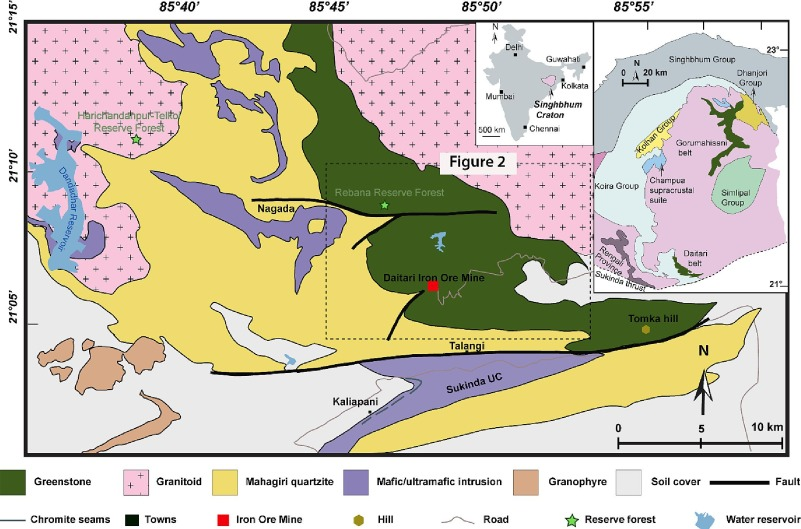Important Facts For Prelims
Daitari Greenstone Belt
- 16 Jun 2023
- 3 min read
Why In News?
A recent research has unveiled remarkably well-preserved volcanic and sedimentary rocks in Singhbhum craton, eastern India, dating back 3.5 billion years.
- Singhbhum craton is stretched across Jharkhand and Odisha between Chhota Nagpur plateau and the Eastern Ghats.
- These findings shed light on India's geologic history and its similarities to regions in South Africa and Australia.
What are the Findings?
- Study Area:
- The study focused on volcanic and sedimentary rocks that formed approximately 3.5 billion years ago in the Daitari greenstone belt in the Singhbhum Craton in east India.
- These rocks are exceptionally well-preserved and offer a glimpse into Earth's past.
- Geologic Makeup of Greenstones:
- The researchers discovered that the Daitari greenstone belt shares similar geological characteristics with the greenstones found in South Africa's Barberton and Nondweni areas, as well as those in Australia's Pilbara Craton.
- This similarity suggests a common geologic history for these regions.
- Sub-Marine Volcanic Activity:
- The study revealed that sub-marine volcanic eruptions were prevalent between 3.5 and 3.3 billion years ago.
- These eruptions left behind pillow lava formations within the greenstone rocks of the Singhbhum, Kaapvaal, and Pilbara cratons.
- Pillow lava is formed when hot molten basaltic magma slowly erupted underwater and solidified rapidly to form roughly spherical or rounded pillow shapes.
- Sub-Marine Sedimentary Rocks:
- Following silicic volcanism, sub-marine turbidity current deposits formed as the volcanic vents drowned.
- These sedimentary rocks provide valuable insights into sub-marine environments and were dated to approximately 3.5 billion years ago using precise detrital U-Pb zircon data.
- Detrital zircon U-Pb geochronology is a tool for sedimentological studies such as provenance, correlation of successions, and definition of maximum depositional ages as well as for studies concerning paleogeographic reconstructions and evolution of the continental crust.
What is the Significance of Findings?
- Understanding Ancient Environments:
- The study of ancient greenstones, including both volcanic and sedimentary rocks, allows scientists to gain insights into habitable environments on Earth during its early stages. These rocks serve as time capsules, providing clues about the planet's evolution.
- Geological Processes:
- These findings contribute to our understanding of diverse volcanic processes and the geologic history of ancient continents.
- Geological Connections:
- The similarities between the geology of India, South Africa, and Australia suggest that these regions may have experienced similar geological processes 3.5 billion years ago.
- Paleogeographic Positioning:
- Further studies may shed light on the paleo-geographic positioning of these ancient continents during that time and contribute to theories related to plate tectonics.





